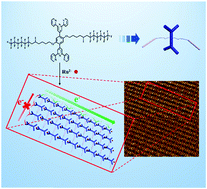An alternating conduction–insulation “molecular fence” model from fluorinated metallopolymers†
Abstract
Introducing fluoroalkyl chains into metallopolymers is a prerequisite to studying the self-organization effect of fluoroalkyl chains and their structure–property relationship. In this work, we present a fluorinated metallopolymer to build an alternating conduction-insulation “molecular fence” model synthesized by the coordination of Ru(II) and a bis-terpyridine-end-capped-phenyl (BTP) ligand modified with fluoroalkyl chains. Taking advantage of scanning tunneling microscopy (STM), a well-aligned periodic linear layered structure is observed clearly, which provides the most direct visualization of the self-organization effect of fluoroalkyl chains for the first time. In addition, combining ultraviolet-visible (UV-vis) absorption spectroscopy and theoretical calculations, we find that fluoroalkyl chains demonstrate a septation effect between two adjacent metallopolymer chains and further restrain the occurrence of interchain charge-transfer transition (ICCT) due to their closed packed structure. This “molecular fence” model can provide a novel route for electron conduction in molecular networks and guide potential applications in the materials science field.



 Please wait while we load your content...
Please wait while we load your content...